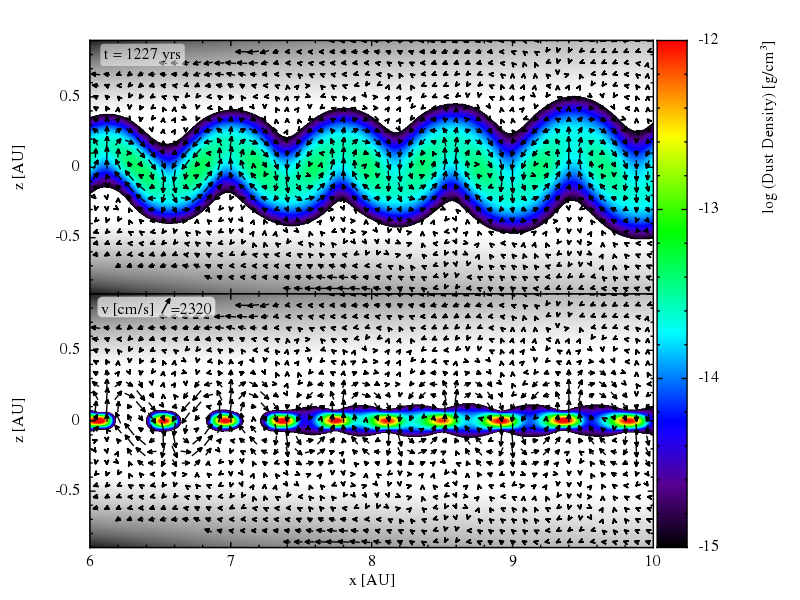Toridal vortices as a solution to the dust migration problemPablo Loren-Aguilar & Matthew R. Bate In an earlier letter, we reported that dust settling in protoplanetary discs may lead to a dynamical dust-gas instability that produces global toroidal vortices. In this Letter, we investigate the evolution of a dusty protoplanetary disc with two different dust species (1 mm and 50 cm dust grains), under the presence of the instability. We show how toroidal vortices, triggered by the interaction of mm grains with the gas, stop the radial migration of metre-sized dust, potentially offering a natural and efficient solution to the dust migration problem. The animations below show the development of the instability in a protoplanetary disc in which two populations of dust particles are initially distributed throughout the gas with a uniform total dust-to-gas density rato of 0.01. Half of the dust mass is in millimetre-sized grains, while the other half is in 50-cm sized particles. The gas disc has a vertical scale height H/r=0.05. The animation shows vertical slices through the disc, giving the azimuthally-averaged gas and dust densities. The top panel shows the gas and small dust, while the lower panel shows the gas and the large dust. The small dust settles towards midplane, but slows as it does so due to drag with the gas forming a dust layer that is thinner than the gas disc. An instability then develops, first at small radii, and then spreading outwards through the disc in which toroidal vortices develop. These deform the dust layer so that it becomes corrugated, and at the same time gather the dust particles towards the centres of the vortices. The large dust, on the other hand, is more weakly coupled to the gas. It initially performs damped oscillations through the midplane, before settling to the mid-plane of the disc. When the torodial vortices develop due to the interaction between the small dust and the gas, these produce pressure maxima and minima at different radii and the large dust migrates radially into the pressure maxima and becomes trapped. Thus, by the end of the simulation, all of the large dust is trapped within dense dust rings that are located between the gas vortices. Refereed Scientific Papers
"Toroidal vortices as a solution to the dust migration problem" AnimationsSimulations & visualisations by Pablo Loren-Aguilar & Matthew Bate, University of Exeter unless stated otherwise. The movies below were produced using the SPLASH software written by Daniel Price to visualise SPH simulations (Price 2007). The animation shows azimuthally-averaged quantities in vertical slices through the disc. The gas density is shown as a grey-scale, while the dust densities are shown using a colour scale. The top panel in the animation shows the density and velocities of the gas and small dust (1mm in size), while the lower panel shows the density and velocities of the gas and large dust (50cm in size). Development of the toroidal vortex instability and trapping of large dust
Copyright: The material on this page is the property of Matthew Bate. Movies and images are released under a Creative Commons Attribution-Noncommercial-Share Alike 3.0 License.
Notes on formats: Technical DetailsThe calculations model the protoplanetary disc orbiting a 1 solar mass star. The disc includes both gas and dust components. The gas disc locally vertically isothermal with a uniform scale height to radius ratio H/r=0.04 and a uniform surface density profile. The gas disc extends from 2.6 to 16.1 AU, with a gas mass of 0.003 solar-masses. Self-gravity is neglected. Initially there is a uniform dust-to-gas density ratio of 0.01 between 5.2 and 15.6 AU, with half of the dust mass in 1mm grains, and the other half in 50cm grains. The dust is taken to be composed of spherical grains with densities of 3 g/cm3. The calculations were performed using a parallel three-dimensional smoothed particle hydrodynamics (SPH) code using 2 million particles for the gas, and 1 millon particles for the dust. The evolution of the dust/gas fluid was modelled using the SPH method of Loren-Aguilar & Bate (2014, 2015). The calculations were performed on STFC's DiRAC Complexity High Performance Computing facility, and the University of Exeter supercomputer. Copyright: Matthew Bate, University of Exeter.
|

